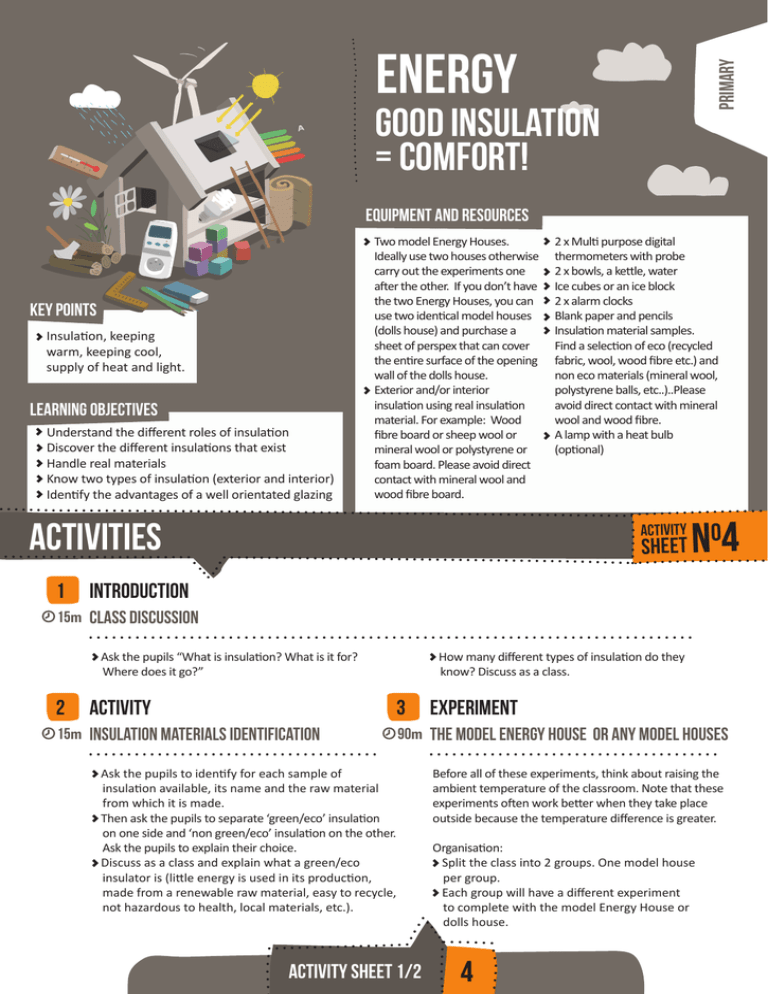Activity 4 – Good insulation = Comfort Activity 4
advertisement

Primary ENERGY GOOD INSULATION = COMFORT! Equipment and Resources Key points Insulation, keeping warm, keeping cool, supply of heat and light. Learning Objectives Understand the different roles of insulation Discover the different insulations that exist Handle real materials Know two types of insulation (exterior and interior) Identify the advantages of a well orientated glazing Two model Energy Houses. Ideally use two houses otherwise carry out the experiments one after the other. If you don’t have the two Energy Houses, you can use two identical model houses (dolls house) and purchase a sheet of perspex that can cover the entire surface of the opening wall of the dolls house. Exterior and/or interior insulation using real insulation material. For example: Wood fibre board or sheep wool or mineral wool or polystyrene or foam board. Please avoid direct contact with mineral wool and wood fibre board. ACTIVITIES 1 2 x Multi purpose digital thermometers with probe 2 x bowls, a kettle, water Ice cubes or an ice block 2 x alarm clocks Blank paper and pencils Insulation material samples. Find a selection of eco (recycled fabric, wool, wood fibre etc.) and non eco materials (mineral wool, polystyrene balls, etc..)..Please avoid direct contact with mineral wool and wood fibre. A lamp with a heat bulb (optional) ACTIVITY SHEET NO4 INTRODUCTION 15m Class Discussion Ask the pupils “What is insulation? What is it for? Where does it go?” 2 ACTIVITY How many different types of insulation do they know? Discuss as a class. 3 15m Insulation Materials Identification EXPERIMENT 90m The Model Energy House or any model houses Ask the pupils to identify for each sample of insulation available, its name and the raw material from which it is made. Then ask the pupils to separate ‘green/eco’ insulation on one side and ‘non green/eco’ insulation on the other. Ask the pupils to explain their choice. Discuss as a class and explain what a green/eco insulator is (little energy is used in its production, made from a renewable raw material, easy to recycle, not hazardous to health, local materials, etc.). aCTIVITY sHEET 1/2 Before all of these experiments, think about raising the ambient temperature of the classroom. Note that these experiments often work better when they take place outside because the temperature difference is greater. Organisation: Split the class into 2 groups. One model house per group. Each group will have a different experiment to complete with the model Energy House or dolls house. 4 Primary ENERGY: GOOD INSULATION = COMFORT! ACTIVITIES (CONTINUED) 3 ACTIVITY SHEET NO4 Experiments Experiment 1: Insulating to Preserve the Heat Take both model houses. Insulate one from the inside and leave the other with no insulation. Put boiling water into two bowls. Place a bowl on the first floor of each house and quickly shut the houses. Wait 15 minutes noting the temperature inside each house every 5 minutes. Compare the results. Experiment 2: Insulating to Preserve Cool TEMPERATURES Take both model houses. Insulate one from the inside and leave the other with no insulation. Put ice cubes in two bowls. Place a bowl on the first floor of each house and quickly shut the houses. Wait 15 minutes noting the temperature inside each house every 5 minutes. Compare the results. Experiment 3: A Glass Wall for Warmth and Light Take both model houses. On the first use the Perspex wall and on the second the plywood wall. If using a dolls house, fix the Perspex with cello tape onto the opening wall. On the other house close the openings of the dolls house. Place the house under direct sunlight or a heat lamp with the perspex side facing the sun or the lamp. Place the other house with the plywood wall facing the sun or heat lamp. Wait 15 minutes noting the temperature inside each house every 5 minutes. Compare the results. Conclusion Hold a class discussion of the results of all 3 experiments: the way they were carried out, the results and the conclusions. Decide as a class the main properties of insulation. Pupils should record all the findings in a workbook. Variation aCTIVITY sHEET 2/2 All these experiments can be carried out using insulation on the inside or outside of the houses. An experiment could be done to compare the two. Pupils can invent other experiments. 4


